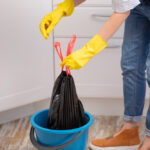While you may not think of it in the same ways necessarily, your home’s garbage disposal is absolutely part of your plumbing system – and requires care just like other elements of this system. In particular, a simple task homeowners can attend to on a regular basis is cleaning their garbage disposal, but many homeowners aren’t sure how to do this or how often it should be done.
At Action Plumbing, Heating, Air & Electric, we’re proud to offer numerous residential plumbing services and areas of assistance, including with basic maintenance and cleaning of any important plumbing component. We’ve helped clients with a variety of garbage disposal needs, including those who are wondering about simple upkeep and cleaning. Here’s a primer on how often this should be done, the equipment you’ll need, and a couple different well-known methods for DIY cleaning on your home’s garbage disposal.
Garbage Disposal Cleaning Frequency
First and foremost, how often should a garbage disposal be cleaned anyway? This is a tougher question than you might think to answer, in large part because part of a garbage disposal’s basic operation involves self-cleaning – by chopping up food and other particles, the disposal itself prevents too many buildups or other issues from taking place.
That said, some problems may develop over time. For instance, a form of slime may be found on the areas that are not involved in the grinding action of the disposal, such as underneath the rubber drain baffle and on the smooth slope at the top of the grinding chamber. If you use the disposal regularly, we recommend cleaning these areas roughly once a week, then deep cleaning once every few months.
Equipment and Materials Needed
Here are all the items you’ll either definitely or potentially need for a basic DIY garbage disposal cleaning:
- A sink stopper
- Rubber gloves
- A kitchen sponge that has at least one abrasive side
- Dish soap
- Ice (for one particular method)
- Half-cup of both baking soda and vinegar (optional, used for a specific method)
- Full cup of rock salt (optional)
- Third-cup of bleach (optional)
Sponge Cleaning Method
First off, we’ll detail how to clean your garbage disposal using nothing but the simple materials above, primarily your dish sponge. This is usually considered the simplest method, and the one you should take as your primary cleaning method for weekly or standard cleaning. Here are the basic steps:
- Power off: This is a safety theme – you need to turn the power to the garbage disposal off so there’s no chance of injuring yourself by turning it on while you’re reaching down it. Don’t simply rely on your ability to not hit the button; accidents happen, and the results here could be horrific. Unplug the disposal from under the sink, or turn off the disposal’s circuit breaker in your electrical panel.
- Baffle cleaning: Apply soap to your baffle, or the plastic element that sits in the disposal drain. Rinse the sponge regularly as you pull out sludge and grime.
- Grinder cleaning: Next, move your sponge carefully around the top of the grinding chamber, continuing to clean it and rinse it off regularly. Continue doing this until the sponge is no longer dirty when you pull it out, a sign that you’ve properly cleaned the interior.
Now, for general weekly cleaning needs, you can stop after you’ve finished these three steps. However, for deeper or periodic cleanings, there are a couple additions you can make to this process that will not only keep the disposal clean, but will also remove odors, clean the drainpipe and perform a more comprehensive cleanup overall.
There are two such methods, described in our next two sections.
Baking Soda and Vinegar
This method involves two simple household items that you’ll usually have around. It follows the steps above, with basic phases that go as follows:
- Pour a half-cup of baking soda into the garbage disposal, then slowly but surely pour in a half-cup of vinegar to follow it up, coating the entire disposal interior.
- Place your sink stopper over the opening of the drain and ensure it’s created a good seal. After a period of time, the baking soda and vinegar will combine, fizzing up and beginning to eat away at clogs or buildups – and your sink stopper will ensure none of these reactions take place near you or your skin.
- After a few minutes once the reaction has subsided, you can pull the sink stopper off and flush the disposal with hot water from your sink. Simultaneously, you should be running the disposal several times to clear any remaining debris.
Ice and Rock Salt Method
If you prefer it, you can use ice and vinegar or rock salt for this cleaning process instead. Here’s how to do it:
- Fill your disposal up with ice cubes from your ice machine.
- Pour a full cup of either rock salt or vinegar into your disposal.
- Run the disposal for several seconds with water turned on, allowing it to grind up the ice. If needed, repeat this process several times.
Smell Concerns
If you’ve tried the above methods and you’re still dealing with poor smells coming from the garbage disposal, bleach should be your next resource. Combine one part bleach with two parts warm water (never using more than one-third cup of bleach total), then wear gloves and pour this solution into the drain. Then run hot water down it for several seconds.
For more on how to clean and maintain your garbage disposal, or to learn about any of our plumbing or HVAC services, speak to the staff at Action Plumbing, Heating, Air & Electric today.


